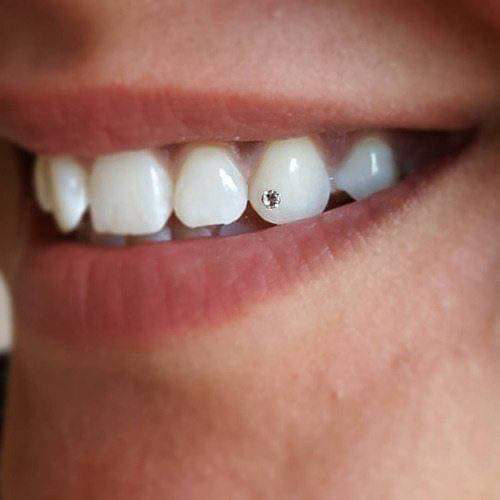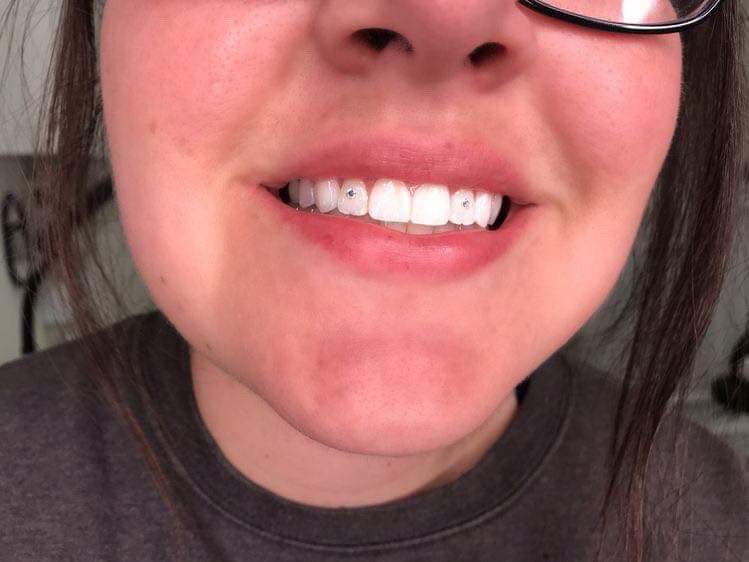Teeth Whitening & Gems
Teeth Whitening & Gems with San Diego Tooth Fairy – Bonnie!

FLAWLESS Teeth Whitening
Professional teeth whitening delivers optimum results in a relatively short amount of time. Performed under the supervision of a certified professional, this method of whitening has gained popularity among those who either are dissatisfied with over-the-counter (OTC) products or don’t want all of the fuss and bother of a professional at-home kit.
Teeth Whitening Frequently Asked Questions
Are whitening products more effective on teeth with stains of certain colors?
Yes. Yellowish teeth respond well to bleaching, brownish-colored teeth respond less well, and grayish-hue or purple-stained teeth may not respond well to bleaching at all. Blue-gray staining caused by tetracycline is more difficult to lighten and may require up to 6 months of home treatments or several in-office appointments to successfully lighten. Teeth that have dark stains may be better candidates for another lightening option, such as veneers, bonding, or crowns. Your dentist can discuss the options best suited for your situation.
With all types of bleaching procedures, the degree of whiteness will vary from individual to individual depending on the condition of the teeth, nature of the stain, the concentration of the bleach and the duration of time and bleaching system used.
What follow-up is needed or is typical?
After in-office whitening, your dentist may want to see you in a few days to check on your gums. If whitening your teeth at home under a dentist-supervised process, your dentist may want to check your gums and your teeth whitening progress after about a week of applications and again a couple weeks later.
How often does the teeth whitening need to be touched up?
Whitening is not permanent. People who expose their teeth to a lot of foods and beverages that cause staining may see the whiteness start to fade in as little as 1 month. Those who avoid foods and beverages that stain may be able to wait 1 year or longer before another whitening treatment or touch-up is needed.
What can I do to maintain my brighter smile?
Tips for maintaining your newly whitened teeth include:
Avoiding the consumption of or exposure to products that stain your teeth (see first question in this document on what causes teeth to become stained). If you do choose to consume beverages that stain, consider using a straw so that the liquid bypasses your front teeth.
Brush or rinse immediately after consuming stain-causing beverages or foods.
Follow good oral hygiene practices. Brush your teeth at least twice daily and floss at least once daily to remove plaque. Use a whitening toothpaste (once or twice a week only) to remove surface stains and prevent yellowing. Use a regular toothpaste the rest of the time.
Consider touch-up treatments. Depending on the whitening method used, you may need a tough-up every 6 months or after a year or two. If you smoke or drink lots of stain-causing beverages, you may need a touch up more often.
Are there any risks associated with teeth whitening?
The two side effects that occur most often are a temporary increase in tooth sensitivity and mild irritation of the soft tissues of the mouth, particularly the gums. Tooth sensitivity often occurs during early stages of the bleaching treatment. Tissue irritation most commonly results from an ill-fitting mouthpiece tray rather than the tooth-bleaching agent. Both of these conditions usually are temporary and disappear within 1 to 3 days of stopping or completing treatment.
If you do experience sensitivity, you can reduce or eliminate it by:
Wearing the tray for a shorter period of time (for example, two 30-minute sessions versus two 60-minute sessions)
Stop whitening your teeth for two to three days to allow your teeth to adjust to the whitening process
Ask your dentist or pharmacist for a high fluoride-containing product, which can help remineralize your teeth. Apply the fluoride product to the tray and wear for 4 minutes prior to and following the whitening agent.
Brush your teeth with a toothpaste made for sensitive teeth. These toothpastes contain potassium nitrate, which helps soothe your teeth’s nerve endings.
Do teeth whiteners damage tooth enamel?Studies of whitening products using 10% carbamide peroxide showed little to no effect on the hardness or mineral content of a tooth’s enamel surface.
Do teeth whiteners damage existing dental restorations?Over 10 years of clinical use of whitening products containing 10% carbamide peroxide have not shown any damage to existing fillings. The issue is not “damage” to existing restorations; rather, keep in mind that existing restorations such as tooth-colored fillings, crowns, bonding, veneers, and bridges do not lighten. This means that any preexisting dental work may need to be replaced to match the new tooth shade achieved in the natural teeth, should a bleaching process proceed.
Do teeth whiteners damage a tooth’s nerve?There’s no evidence to date that the tooth whitening process has a harmful effect on the health of a tooth’s nerve. One study reported that at both a 4.5 and 7-year follow up, no individual who used a tooth whitening system needed a root canal procedure on any teeth that had been whitened.
© 1995-2009 The Cleveland Clinic Foundation. All rights reserved.
Teeth Gems
A tooth gem is a small rhinestone jewel is attached to the surface of a tooth using an adhesive. Some are small stones in the center of the tooth, other times people elect to place a jewel-encrusted cap over their teeth.
Swarovski Tooth Jewels are simple, subtle and shimmering! Swarovski® is considered to produce the finest precision-cut crystals in the world. Their crystals are polished to the highest standards of quality and sparkle like diamonds.
Our tooth jewelry is made by Genuine Swarovski Crystals that are small in diameter and applied to the tooth using safe dental materials. Our application requires no drilling and no holes. It is completely painless, will not harm the tooth, and can be easily removed. It is perfect for those who want a bit of glamour and fun! They are truly chic, yet elegant. We also offer gold and diamond jewels as well as different shapes, colors & size 2mm & up!

How long will the tooth jewel last?
Anywhere from 6 months up to 24 months for the Swarovski Crystals, Brilliance Crystals and Shaped Crystals.
6 Months -12 Months for the Real Gold Charms & Real Diamonds (Due to the extra Weight on these Specific Charms)
Can I feel the Tooth jewel on my tooth?
Tooth jewels are only 0.4mm or 0.9mm thick and 1.8mm to 3mm in diameter. Initially something on your tooth will feel different, but a few days after the application you will get used to the new feeling.
Will the jewel harm my tooth?
No. The jewel is bonded to the enamel like a orthodontic bracket without any drilling or pain. The procedure and removal can be compared to the placement and removal of orthodontic brackets. When it is removed the tooth jewel is simply popped off and the tooth will be polished to remove any remaining bonding material.
Does the jewel impede brushing?
No, the presence of the tooth jewel will not make any difference regarding dental hygiene. However, it is recommended not to use an electric toothbrush.
What if the jewel falls off and I swallow it?
The jewels are tiny glass crystals or gold. They have no sharp edges. It will come out the other end.
Can I still have my teeth cleaned by my dentist/hygienist?
You can and should still have your teeth cleaned by a professional. Tooth jewelry will not cause a problem for the hygienist cleaning your teeth. The area underneath the jewel is sealed like a filling and will not let in any bacteria. The hygienist can easily polish on top and around the jewel with a soft point.
Simple Facts about Tooth Jewelry
- It is non-invasive and painless.
- Requires no extra maintenance.
- Can be removed or replaced anytime has no effect on the tooth enamel once the jewel is removed or replaced.
- Involves a procedure that only takes about 15 minutes and is 100% reversible.
- It is stain resistant.
- Does not obstruct regular brushing even if using an electric toothbrush nor restrict you from visiting your dentist or dental hygienist.
- You can have a jewel applied as a temporary enhancement which will last from 1- 6 weeks or a semi-permanent which will stay on until you decide to have it removed.
AFTERCARE
- DO NOT TOUCH OR PLAY WITH CRYSTAL.
- DO NOT EAT FOR 1 HOUR AFTER CRYSTAL IS PLACED. YOU CAN DRINK WATER IMMEDIATELY.
- EAT ONLY SOFT FOODS FOR THE 1ST 12 HOURS.
- DO NOT BRUSH YOUR TEETH FOR 12 HOURS. IT IS RECOMMENDED TO NOT USE AN ELECTRIC TOOTHBRUSH FOR THE FIRST 24 HOURS AFTER A JEWEL HAS BEEN PLACED.
Teeth Goals
We are so excited for your new look!


